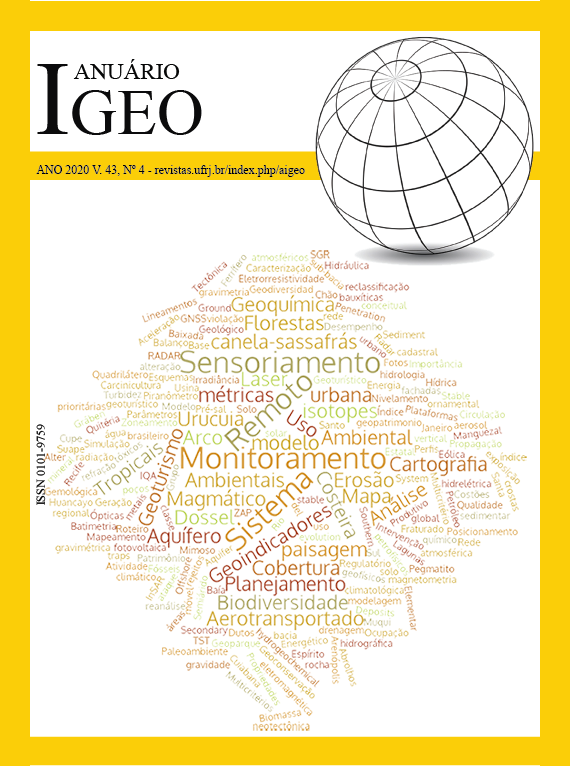Impacto do Gelo Marinho Antártico, do ENOS e do Modo Anular Sul sobre as Frentes Frias na América do Sul
DOI:
https://doi.org/10.11137/2020_4_229_237Keywords:
Sistemas frontais, Gelo marinho antártico, Padrões de teleconexãoAbstract
Padrões de teleconexões, tais como El Niño-Oscilação Sul (ENOS) e o Modo Anular Sul (SAM) afetam a circulação e, consequentemente, o clima da América do Sul. Alguns trabalhos mostram que esses padrões podem estar relacionados a variações na ocorrência de sistemas transientes, tais como, as frentes frias. A extensão de gelo marinho antártico também afeta a circulação em todo o Hemisfério Sul. Porém, não há um estudo analisando os impactos em conjunto do ENOS, do SAM e do gelo marinho antártico na atuação das frentes frias na América do Sul. Desta forma, o objetivo deste trabalho foi avaliar a frequência de frentes frias na América do Sul nos anos com anomalias do gelo marinho antártico nos mares de Bellingshausen-Amundsen (MBA) e Weddel (MWD) em conjunto com a atuação das fases do SAM e do ENOS. Os resultados apresentam diferença nas atuações das frentes entre o continente e o Oceano Atlântico adjacente. Em geral, para ambos os mares analisados, é possível notar a atuação da La Niña e SAM positivo em
todas as análises de frequências máximas de frentes frias sobre o oceano, variando somente a extensão do gelo marinho. No continente, o El Niño junto com a fase negativa do SAM domina as máximas frequências de frentes em ambas as extensões de gelo marinho no MBA e combinado com máxima extensão de gelo marinho no MWD. As diferenças entre o oceano e continente indicam que os três fatores (SAM, ENOS e gelo marinho) influenciam na trajetória das frentes, mais meridional e continental ou então mais marítima.
References
Andrade, K.M. 2005. Climatologia e comportamento dos sistemas frontais sobre a América do Sul. Programa de Pós-Graduação em Meteorologia, Instituto Nacional de Pesquisas Espaciais (INPE), Dissertação de Mestrado, 185p.
Cavalcanti, I.F.A. & Ambrizzi, T. 2009. Teleconexões e influências no Brasil. In: CAVALCANTI, I.F.A.; Ferreira, N.J.; Silva, M.G.A.J. & Dias, M.A.F.S. (ed.). Tempo e clima no Brasil. São Paulo, Oficina de textos, p. 463. ISBN 9788586238925
Cavalcanti, I.F.A. & Kousky, V.E. 2003. Climatology of South American cold fronts. In: INTERNATIONAL CONFERENCE ON SOUTHERN HEMISPHERE METEOROLOGY AND OCEANOGRAPHY, 7., Wellington, New Zealand, 2003. Proceedings, New Zealand, American Meteorological Society.
Cavalcanti, I.F.A. & Kousky, V.E. 2009. Frentes Frias sobre o Brasil. In: CAVALCANTI, I.F.A.; Ferreira, N.J.; Silva, M.G.A.J. & Dias, M.A.F.S. (ed.). Tempo e clima no Brasil. São Paulo, Oficina de textos, p. 463. ISBN 9788586238925
Cavalieri, D.J. & Parkinson, C.L. 2008. Antarctic sea ice variability and trends, 1979–2006. Journal of Geophysical Research, 113: 1-19. DOI: https://doi.org/10.1029/2007JC004558
Comiso, J.C. 2017. Bootstrap Sea Ice Concentrations from Nimbus-7 SMMR and DMSP SSM/I-SSMIS, Version 3. Boulder, Colorado USA. NASA National Snow and Ice Data Center Distributed Active Archive Center. DOI: https://doi.org/10.5067/7Q8HCCWS4I0R
Dee, D.P.; Uppala, S.M.; Simmons, A.J.; Berrisford, P.; Poli, P.; Kobayashi, S.; Andrae, U.; Balmaseda, M.A.; Balsamo, G.; Bauer, P.; Bechtold, P.; Beljaars, A.C.M.; Van de Berg, L.; Bidlot, J.; Bormann, N.; Delsol, C.; Dragani, R.; Fuentes, M.; Geer, A.J.; Haimberger, L.; Healy, S.B.; Hersbach, H.; Hólm, E.V.; Isaksen, L.; Kållberg, P.; Köhler, M.; Matricardi, M.; McNally, A.P.; Monge‐Sanz, B.M.; Morcrette, J.‐J.; Park, B.‐K.; Peubey, C.; de Rosnay, P.; Tavolato, C.; Thépaut, J.‐N & Vitart, F. 2011, The ERA-Interim reanalysis: configuration and performance of the data assimilation system. Quarterly Journal of the Royal Meteorological Society, 137: 553–597. DOI: 10.1002/qj.828
Dereczynski, C.P.; Lopes, I.R.; Carvalho, N.O.; Silva, M.G.A.J.; Grossmann, K.S. & Martins, R.P. 2019. Climatology of Espírito Santo and the Northern Campos Basin, Ofshore Southeast Brazil. Anuário do Instituto de Geociências, 42: 386-401. DOI: http://dx.doi.org/10.11137/2019_1_386_401
Fedorova, N. & Carvalho, M.H. 2000. Processos sinóticos em anos de La Niña e de El Niño. Parte II: Zonas frontais. Revista Brasileira de Meteorologia,15: 57-72.
Gillett, N.P.; Kell, T.D. & Jones, P.D. 2006. Regional climate impacts of the Southern Annular Mode. Geophysical Research Letters 33: L23704. DOI: https://doi.org/10.1029/2006GL027721
Pezza, A.B.; Rashid, H.A. & Simmonds, I. 2012. Climate links and recent extremes in Antarctic sea ice, high-latitude cyclones, Southern Annular Mode and ENSO. Climate Dynamics, 38: 57–73. DOI: https://doi.org/10.1007/s00382-011-1044-y
Philander, S. G. 1990. El Niño, La Niña and the Southern Oscillation. San Diego, California. Academic Press. 293p.
Reboita, M.S.; Ambrizzi, T. & Rocha, R.P.D. 2009. Relationship between the Southern Annullar Mode and the Southern Hemisphere atmospheric systems. Revista Brasileira de Meteorologia, 24: 48–55. DOI: http://dx.doi.org/10.1590/S0102-77862009000100005.
Tedeschi, R.G.; Cavalcanti, I.F.A. & Grimm, A.M. 2013. Influences of two types of ENSO on South American precipitation. International Journal of Climatology, 33: 1382-1400. DOI: https://doi.org/10.1002/joc.3519
Thompson, D.W.J & Wallace, J.M. 2000. Annular Modes in the Extratropical Circulation. Part I: Month-to-Month Variability. Journal of Climate, 13: 1000- 1017: DOI: https://doi.org/10.1175/1520-0442(2000)013<1000:AMITEC>2.0.CO;2
Trenberth, K.E., 1997: The Definition of El Niño. Bulletin of American Meteorological Society, 78: 2771–2778. DOI: https://doi.org/10.1175/1520-0477(1997)078<2771:TDOENO>2.0.CO;2.
Vasconcellos, F.C.; Pizzochero, R.M. & Cavalcanti, I.F.A. 2019, Month-to-month impacts of Southern Annular Mode over South America climate. Anuário do Instituto de Geociências, 41: 783-792. DOI: http://dx.doi.org/10.11137/2019_1_783_792
Vera, C.; Silvestri, G.; Barros, V & Carril, A. 2004. Differences in El Niño response over the Southern Hemisphere. Journal of Climate, 17: 1741–1753. DOI: https://doi.org/10.1175/1520-0442(2004)017<1741:DIENRO>2.0.CO;2
Wadhams, P. 2000. Ice in the ocean. Amsterdam, Gordon and Breach Science Publishers, 351p.
Wilks, D.S. 2006. Statistical methods in the atmospheric sciences. San Diego, CA: Academic Press. 627p. (International Geophysics Series 91) ISBN 978-0-12-751966-1
Yuan X.J. & Martinson D.G. 2000. Antarctic Sea Ice Extent Variability and Its Global Connectivity. Journal of Climate, 13: 1697–1717. DOI: 10.1175/1520-0442(2000)013<1697:ASIEVA>2.0.CO;2
Downloads
Published
Issue
Section
License
This journal is licensed under a Creative Commons — Attribution 4.0 International — CC BY 4.0, which permits use, distribution and reproduction in any medium, provided the original work is properly cited.
















 Except where otherwise noted, content on this site is licensed under a license
Except where otherwise noted, content on this site is licensed under a license 